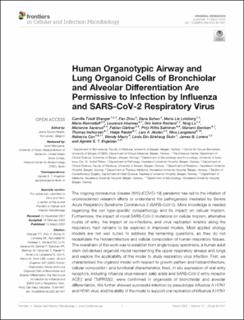| dc.contributor.author | Ekanger, Camilla Tvedt | |
| dc.contributor.author | Zhou, Fan | |
| dc.contributor.author | Bohan, Dana | |
| dc.contributor.author | Lotsberg, Maria Lie | |
| dc.contributor.author | Ramnefjell, Maria | |
| dc.contributor.author | Hoareau, Laurence | |
| dc.contributor.author | Røsland, Gro Vatne | |
| dc.contributor.author | Lu, Ning | |
| dc.contributor.author | Aanerud, Marianne | |
| dc.contributor.author | Gärtner, Fabian | |
| dc.contributor.author | Salminen, Pirjo-Riitta | |
| dc.contributor.author | Bentsen, Mariann | |
| dc.contributor.author | Halvorsen, Thomas | |
| dc.contributor.author | Ræder, Helge | |
| dc.contributor.author | Akslen, Lars Andreas | |
| dc.contributor.author | Langeland, Nina | |
| dc.contributor.author | Brokstad, Rebecca Jane Cox | |
| dc.contributor.author | Maury, Wendy | |
| dc.contributor.author | Stuhr, Linda Elin Birkhaug | |
| dc.contributor.author | Lorens, James | |
| dc.contributor.author | Engelsen, Agnete Svendsen Tenfjord | |
| dc.date.accessioned | 2022-06-09T13:50:42Z | |
| dc.date.available | 2022-06-09T13:50:42Z | |
| dc.date.created | 2022-03-14T13:28:05Z | |
| dc.date.issued | 2022 | |
| dc.identifier.issn | 2235-2988 | |
| dc.identifier.uri | https://hdl.handle.net/11250/2998188 | |
| dc.description.abstract | The ongoing coronavirus disease 2019 (COVID-19) pandemic has led to the initiation of unprecedented research efforts to understand the pathogenesis mediated by Severe Acute Respiratory Syndrome Coronavirus 2 (SARS-CoV-2). More knowledge is needed regarding the cell type-specific cytopathology and its impact on cellular tropism. Furthermore, the impact of novel SARS-CoV-2 mutations on cellular tropism, alternative routes of entry, the impact of co-infections, and virus replication kinetics along the respiratory tract remains to be explored in improved models. Most applied virology models are not well suited to address the remaining questions, as they do not recapitulate the histoarchitecture and cellular composition of human respiratory tissues. The overall aim of this work was to establish from single biopsy specimens, a human adult stem cell-derived organoid model representing the upper respiratory airways and lungs and explore the applicability of this model to study respiratory virus infection. First, we characterized the organoid model with respect to growth pattern and histoarchitecture, cellular composition, and functional characteristics. Next, in situ expression of viral entry receptors, including influenza virus-relevant sialic acids and SARS-CoV-2 entry receptor ACE2 and TMPRSS2, were confirmed in organoids of bronchiolar and alveolar differentiation. We further showed successful infection by pseudotype influenza A H7N1 and H5N1 virus, and the ability of the model to support viral replication of influenza A H7N1 virus. Finally, successful infection and replication of a clinical isolate of SARS-CoV-2 were confirmed in the organoids by TCID50 assay and immunostaining to detect intracellular SARS-CoV-2 specific nucleocapsid and dsRNA. The prominent syncytia formation in organoid tissues following SARS-CoV-2 infection mimics the findings from infected human tissues in situ. We conclude that the human organotypic model described here may be particularly useful for virology studies to evaluate regional differences in the host response to infection. The model contains the various cell types along the respiratory tract, expresses respiratory virus entry factors, and supports successful infection and replication of influenza virus and SARS-CoV-2. Thus, the model may serve as a relevant and reliable tool in virology and aid in pandemic preparedness, and efficient evaluation of antiviral strategies. | en_US |
| dc.language.iso | eng | en_US |
| dc.publisher | Frontiers Media | en_US |
| dc.rights | Navngivelse 4.0 Internasjonal | * |
| dc.rights.uri | http://creativecommons.org/licenses/by/4.0/deed.no | * |
| dc.title | Human organotypic airway and lung organoid cells of bronchiolar and alveolar differentiation are permissive to infection by influenza and SARS-CoV-2 respiratory virus | en_US |
| dc.type | Journal article | en_US |
| dc.type | Peer reviewed | en_US |
| dc.description.version | publishedVersion | en_US |
| dc.rights.holder | © 2022 Ekanger, Zhou, Bohan, Lotsberg, Ramnefjell, Hoareau, Røsland, Lu, Aanerud, Gärtner, Salminen, Bentsen, Halvorsen, Ræder, Akslen, Langeland, Cox, Maury, Stuhr, Lorens and Engelsen. | en_US |
| dc.source.articlenumber | 841447 | en_US |
| cristin.ispublished | true | |
| cristin.fulltext | original | |
| cristin.qualitycode | 1 | |
| dc.identifier.doi | 10.3389/fcimb.2022.841447 | |
| dc.identifier.cristin | 2009545 | |
| dc.source.journal | Frontiers in Cellular and Infection Microbiology | en_US |
| dc.identifier.citation | Frontiers in Cellular and Infection Microbiology. 2022, 12:841447. | en_US |
| dc.source.volume | 12 | en_US |

